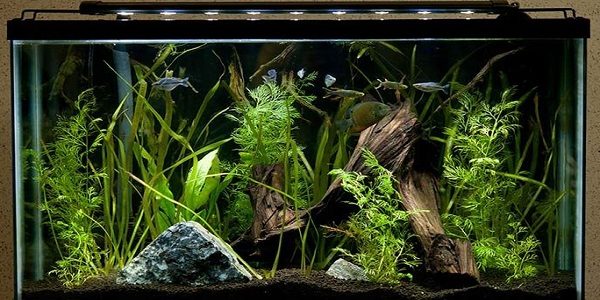When you see an aquarium,the first things you may notice are the fish, the decorations, or even the luxurious plants. You never notice the lights, even if the lights are what make the entire aquarium survive and develop.

Since lighting is so important, you need to pay great attention when you choose it. It’s an investment that you cannot neglect; no matter how great the other equipment is, your plants and fish will never develop properly without the necessary lighting. When you choose the lighting, make sure that it has the right color spectrum; different types of fish have different needs so do not rush into buying the first bulb you see.
On the other hand, too much light can fill your aquarium with algae, especially if your tank is placed in front of the window. Your fish can lose their appetite and it will be almost impossible to reproduce them. There always has to be a balance between the appearance of the aquarium, the needs of your plants, and the needs of your fish.
How to choose the right light?
First of all, you need to find out what lighting your tank requires. For example, if you have a small tank that is not very deep and the plants do not require too much light, you can opt for normal fluorescent lights. They will not produce a lot of heat, so it’s great for cold water fish; on the other hand, the plants on the bottom of the tank will not get too much light.
LED lights can be more expensive and many people hesitate to make such an investment due to the price. Even so, LEDs are energy efficient and they last a long time, not to mention that you can choose the exact intensity and color.
The compact fluorescent lights will produce medium heat, but they will offer you intense light without using too much energy. It can be complex to install them on the hood of the tank if the same manufacturer does not produce them, but they are versatile and allow you to build your own system.

For a big tank with luxurious, intense light you will need Metal Halide lamps; they do produce a lot of heat, but they will also change the complete appearance of your tank. The hood of the tank must have a fan to balance the temperature of the water otherwise your fish will not survive for long.In some cases, you might even need a chiller if your fish require cold water. Metal Halide lamps are pricier and not really energy efficient, but you can solve this by installing a timer to ensure the lights are only on for the necessary amount of time.
Related Review: Best LED Aquarium Lighting
How to install the lighting?
Installation depends entirely on the type of tank you have and your preferences. The fish and the plants will not be affected by the setup as long as you provide them with what they need. Also, keep in mind that you have to decide how many bulbs you need before you start the setup; depending on how you install them, it can be difficult to add another bulb later.
The simplest way to solve this issue is to buy an aquarium with a hood. The hood will have a special place for the lighting and all you have to do is attach the bulb(s) you wish. Also, you will not have to worry about all the wires tanglingsince the hood will hide them very well and it will keep all your equipment in order. You can build a hood on your own if the aquarium does not have one and use silicone to attach a plinth for the bulbs. Drill some holes for the wires and you’re all done!
If your tank does not have a hood and you are not planning to get one, you can get a lighting support; this is basically like a desk lamp, but the bulbs will be placed exactly above the aquarium. The disadvantage of this (or advantage if you have cold-water fish) is the heat will not be preserved and you might need a heater.
Be innovative and think about the best way to maintain your tank while still keeping your budget. If this means you have to build the plinth by yourself, then go ahead and do it. All the effort will be worth it in the end when you see your amazing tank!
No related posts.
